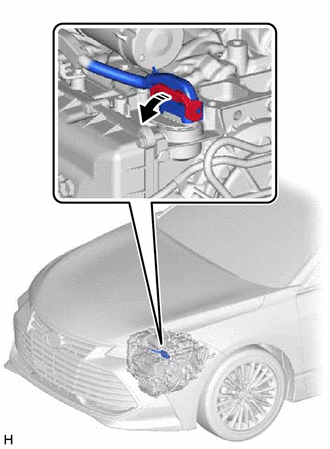Mechanical System Tests
MECHANICAL SYSTEM TESTS
STALL SPEED TEST
CAUTION:
- Do not perform a stall test if there are any people or objects near the vehicle.
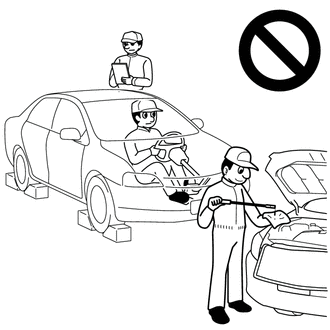
- The vehicle could begin moving suddenly, resulting in a serious accident.
- Do not perform a stall test if any wheel chocks are out of position.
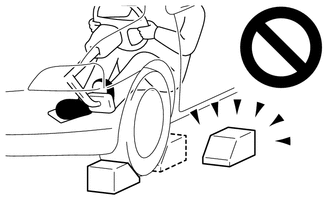
- The vehicle could begin moving suddenly, resulting in a serious accident.
- Do not perform the stall test on a slippery or low-friction surface that could allow the tires to spin.
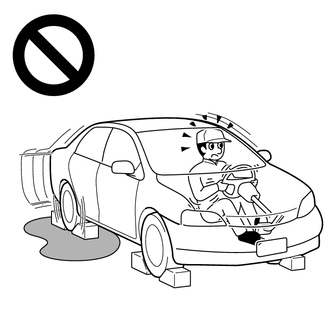
- The vehicle could begin moving suddenly, resulting in a serious accident.
NOTICE:
- Do not perform the stall speed test for longer than 5 seconds.
- When performing the stall speed test repeatedly, wait for 15 seconds or more between tests.
- Perform this test with the ATF (Automatic Transaxle Fluid) at the normal operating temperature: 50 to 80°C (122 to 176°F)
- Perform this test with the AUTO function (shift-linked function) of the electronic parking brake system off.
HINT:
This test is to check the overall performance of the engine and transaxle.
(a) Connect the Techstream to the DLC3.
(b) Drive the vehicle until the transaxle fluid temperature has reached 50 to 80°C (122 to 176°F).
(c) Allow the engine to idle with the air conditioning and headlights off.
(d) Chock all 4 wheels.
(e) Set the parking brake and keep the brake pedal depressed firmly with your left foot.
HINT:
When
the parking brake indicator (red) is illuminated after the electric
parking brake switch (electric parking brake switch assembly) has been
pulled to the lock side, the maximum amount of braking force is applied
if the electric parking brake switch (electric parking brake switch
assembly) is pulled to the lock side one more time.
(f) Move the shift lever to D.
(g) Depress the accelerator pedal as much as possible with your right foot.
(h) Read the engine speed (stall speed) and release the accelerator pedal immediately.
Standard Value:
|
Stall Speed |
|
2370 rpm | + 200 rpm |
|
- 300 rpm |
Evaluation |
Test Result | Possible Cause |
|
Stall speed is lower than standard value |
- Engine power output may be insufficient
- Stator one-way clutch not operating properly
HINT: If the value is less than the specified value by 600 rpm or more, the torque converter assembly may be malfunctioning. |
|
Stall speed is higher than standard value |
- Line pressure is too low
- No. 1 clutch (C1) slipping
- No. 2 brake (B2) slipping
- Improper fluid level
|
SHIFT TIME LAG TEST
NOTICE:
Perform this test with the AUTO function (shift-linked function) of the electronic parking brake system off.
HINT:
When
the shift lever is moved while the engine is idling, there will be a
certain time lapse or lag before shock can be felt. This is used for
checking the condition of the clutch and brake.
(a) Connect the Techstream to the DLC3.
(b) Drive the vehicle until the transaxle fluid temperature has reached 50 to 80°C (122 to 176°F).
(c) Allow the engine to idle with the air conditioning off.
(d) Set the parking brake and keep the brake pedal depressed firmly.
HINT:
When
the parking brake indicator (red) is illuminated after the electric
parking brake switch (electric parking brake switch assembly) has been
pulled to the lock side, the maximum amount of braking force is applied
if the electric parking brake switch (electric parking brake switch
assembly) is pulled to the lock side one more time.
(e) Check the D position time lag.
(1) Move the shift lever to N and wait for 1 minute.
(2) Move the shift lever to D and measure the time until shock is felt.
(3) Repeat the 2 steps above 3 times, and calculate the average time of the 3 tests.
Standard Value:
D position time lag is less than 1.5 seconds
(f) Check the R position time lag.
(1) Move the shift lever to N and wait for 1 minute.
(2) Move the shift lever to R and measure the time until shock is felt.
(3) Repeat the 2 steps above 3 times, and calculate the average time of the 3 tests.
Standard Value:
R position time lag is less than 1.5 seconds
Evaluation |
Test Result | Possible Cause |
|
D position time lag exceeds standard value |
- Line pressure is low
- No. 1 clutch (C1) is worn
- No. 2 brake (B2) is worn
|
| R position time lag exceeds standard value |
- Line pressure is low
- No. 3 clutch (C3) is worn
- No. 2 brake (B2) is worn
|
Monitor Drive Pattern
MONITOR DRIVE PATTERN
MONITOR DRIVE PATTERN FOR ECT
CAUTION:
Perform the following procedure on a level surface while strictly observing all traffic laws and speed limits.
HINT:
Performing
this drive pattern is one method to simulate ECM (ECT) malfunction
detection conditions. Some DTCs may not be detected through ordinary,
everyday driving. Also, some DTCs may not be detected through this drive
pattern.
(a) Preparation for driving
(1) Warm up the engine sufficiently (engine coolant temperature of 60°C (140°F) or higher).
(2) Drive the vehicle when the ambient temperature is -10°C (14°F) or higher.
Some malfunctions are not detected when the ambient temperature is less than -10°C (14°F).
(b) Drive pattern
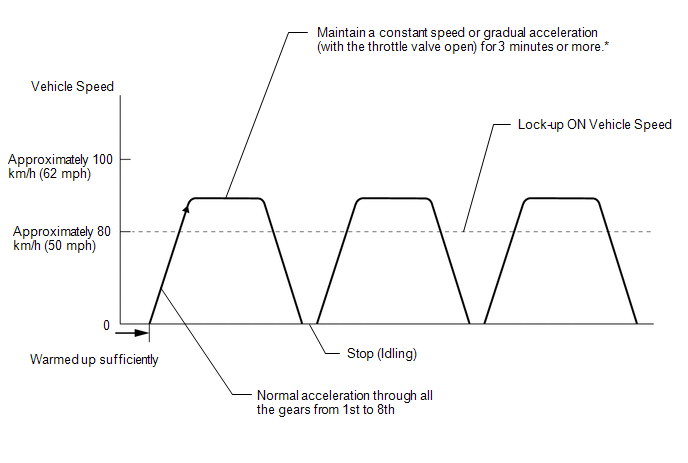
*: Drive at a speed in the highest gear that will cause lock-up to
engage. The vehicle can be driven at a speed lower than the speed shown
in the above diagram under lock-up.
(1) Drive the vehicle through all of the gears.
Stop → 1st → 2nd → 3rd → 4th → 5th → 6th → 7th → 8th.
HINT:
Lock-up will be engaged while driving in 2nd gear or higher.
(2)
Perform an engine braking test with the shift lever in S. While driving
in S8 with 8th gear lock-up, move the shift lever to "-" and down-shift
from 8th → 7th, 7th → 6th, 6th → 5th, 5th → 4th, 4th → 3rd, 3rd → 2nd
and 2nd → 1st.
Check that engine braking is normal for every down-shift.
(3) Repeat the above drive pattern 3 times or more.
NOTICE:
- When using the Techstream, the monitor status can be checked in the Data List.
Click here 
- In the event that the drive pattern must be interrupted (due to traffic
conditions or other factors), the drive pattern can be resumed and, in
most cases, the monitor can be completed.
- Perform this drive pattern on a level road as much as possible and
strictly observe the posted speed limits and traffic laws while driving.
- It is necessary to drive the vehicle for approximately 30 minutes to detect DTC P071000 (ATF temperature sensor malfunction).
